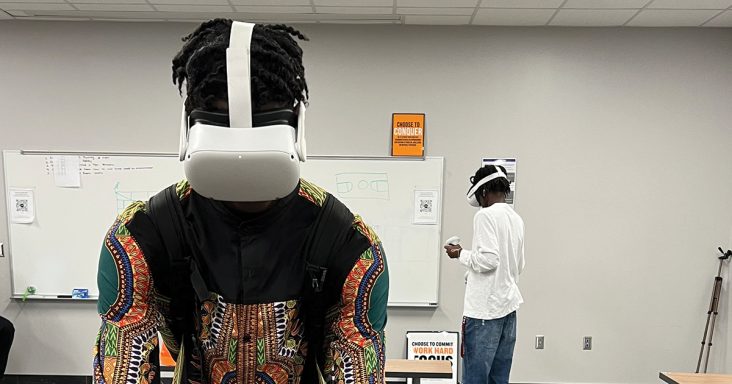VR simulation program aids in Arkansas Northeastern College workforce training
by February 8, 2023 7:23 pm 844 views

Training for some vocations has been a time and opportunity obstacle for many community colleges for years. If a student wanted to become a crane operator, part of the education requirement would require the student to spend hours in live training on the crane.
In many parts of the state that would be a significant issue if there were no cranes available. But a new virtual reality program could render problems like this moot, Arkansas Northeastern College (ANC) Associate Vice President for Workforce Development and Allied Technologies Dr. Jamie Frakes told Talk Business & Politics.
The Transfr Career Exploration program was instituted at ANC about a year ago. Transfr is a New York City-based company that provides the simulation program and other “career exploration” products. The program provides students with hands-on simulations in different career paths that allow students and job seekers to understand career options. It also allows them to experience what it’s like to work different kinds of jobs, and will guide them toward a desired career path, the school stated.
“It provides simulations of different career paths,” Frakes said. “It’s as if they are on the job, learning how to do it firsthand.”
There are a vast number of disciplines that are covered by the virtual reality program. Manufacturing programs cover a number of careers including manufacturing production, process development, robot repair, maintenance, installation and repair and quality assurance. Skilled trades, warehousing and storage, public safety, hospitality and tourism, automotive, and other career fields are covered by the program.
A Talk Business & Politics reporter experienced several of the simulation programs including the crane operation, robot repair, and firefighter training. Students are required to wear a headset that covers their eyes. Controllers are placed in each hand, and when the simulation begins the controllers function as hands.
It takes a little training to figure out which buttons on the controllers control specific functions. Once that training is complete, the simulation begins with instructions and tasks to be performed. The simulation is realistic and the student has to have a certain amount of space around them.
At the end of each lesson, the student is required to take a test and perform the task up to standard. For example, during the firefighting simulation, a student must unpin a fire extinguisher in the proper order, and identify what type of fire has to be put out. The last step is to use proper technique when using the extinguisher. In years past, students would have to watch videos to learn these techniques, Frakes said. In some cases, students could go on-site and experience the job, but that was often time-consuming and difficult, he said.
Frakes estimates that several hundred students have used the simulators since the school acquired the program. The units, with the headgear and controllers, cost up to $5,000 each.
One advantage for students is figuring out what they don’t want to do,” Frakes said.
“We’ve had students tell us, after they’ve looked through the viewfinder, that they don’t want to do that particular job,” he said. “This can help them save time and money. It gives them the information they need to seek another career.”
Finding trained and qualified workers will be a significant challenge in the coming decade as those born in the Baby Boom generation head for retirement. According to Pew Research Center, the rate of retirement for Boomers has accelerated since COVID-19 began. Nearly 29 million Boomers retired in 2020, 3 million more than in 2019. Seventy-five million Boomers are expected to retire by 2030, paving the way for what is now called The Great Retirement, which may surpass The Great Resignation as the most significant hiring trend for 2022.
The Great Retirement is an unprecedented flood of retirees exiting the workforce earlier than planned. This event was triggered by the pandemic and heavily involved Boomers. Whether it is to enjoy life, address health concerns, or leave a changing work environment, the workforce in recent years has seen an uptick in retirement. By the fall of 2020, according to the Pew Research Center, almost 30 million Boomers had retired, an increase of 213% from the previous year, J2T Recruiting reported.
One in four U.S. workers is a Boomer, amounting to 41 million in total. The mass retirement likely will lead to an even wider workforce gap as companies will need to fill positions made available after the Boomers’ retirement.
ANC is located in Blytheville which is in Mississippi County, the largest steel producing county in the U.S. and it’s one of the manufacturing hubs in Arkansas. One thing Frakes said he hopes in the future is that some of the local manufacturers will utilize the program for their workers.
Another change he expects is a technology upgrade for the controllers in the coming year. That would make it more user friendly and would help students get up to speed quicker, he said.
How will the program impact student outcomes?
“The sky is truly the limit with this program. … It makes learning fun,” Frakes said.
